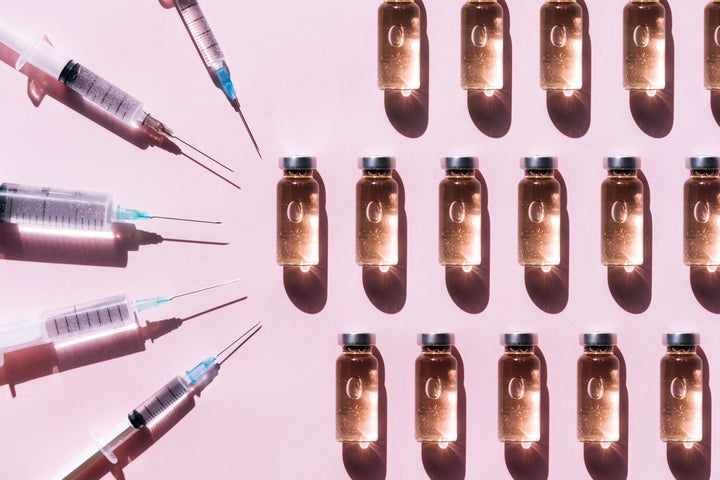Can it really prevent wrinkles? How young is too young to get this procedure? Here’s an all-encompassing guide to this popular treatment.
If you’ve always loved the look of smooth, line-free skin but never had the courage to get there with injectables, we have two words for you: baby Botox. The treatment, rooted in the same complexion-refreshing goal as traditional Botox, provides natural results and is a mild introduction to needles if you’re new to them. The big reason a lot of young people are opting for the procedure? It’s a preventative measure against wrinkles.
But is it safe? And is there a minimum age that experts recommend? Who exactly is it right and wrong for?
HuffPost spoke with dermatologists to learn about baby Botox, including whether it actually helps with wrinkles or is solely a preventative treatment.
What is baby Botox?
Botox is a neurotoxin that gets injected directly into the muscle to prevent it from contracting, said SkinSpirit Gaithersburg aesthetic nurse practitioner Caroline Ruhl. Those seeking baby Botox get treated with the same product — they just receive smaller amounts of the injectable than people who get traditional Botox.
Brian Hibler, a board-certified dermatologist at Schweiger Dermatology Group in New York City, said that the ideal candidate for baby Botox is a patient in their 20s to 30s without static lines on the forehead or glabella (the area above the eyebrows, otherwise known as the “elevens”).
“Static lines are those that are present at rest, even without movement,” Hibler noted. “If lines are present at rest, this typically requires more units to reduce more muscle movement and prevent these lines from etching in deeper.” In this case, a traditional Botox treatment may be in order.
What are the benefits of baby Botox?
There are several benefits to baby Botox. For one, it’s a slow transition into the world of neurotoxins for those who are new to them, Ruhl said. Baby Botox also yields more natural-looking results. While traditional Botox can give the appearance of a “frozen” muscle, baby Botox gives the appearance of a “softened” muscle.
This is ideal for those who don’t have significant movement in their skin and therefore don’t require as many units to relax the muscles as, say, someone who has deeper lines at rest, Hibler said. While baby Botox won’t eliminate the appearance of fine lines and wrinkles completely, it’ll certainly make them less noticeable.
Perhaps one of the biggest reasons people seek out baby Botox is that it’s a preventative treatment.
“The real benefit of starting Botox treatments early is the prevention of lines,” Hibler said. “We know that with repeated neuromodulator treatments over many years, we can prevent the formation of deep, etched lines.” And it’s easier to prevent the formation of these lines rather than correct them later, he added.
What happens during the procedure?
It’s best not to wear any makeup to your appointment. Still, your provider should cleanse your face as well as wipe it down with an antimicrobial wipe prior to injection, Ruhl noted.
As far as the pain levels go, Botox (and baby Botox) is injected with one of the smallest-gauge needles and feels like a small pinch. Prior to the treatment, ice or numbing medication may be applied to relieve any discomfort, but Botox is generally regarded as one of the most tolerable — and quick — injectable treatments.

You should always discuss areas of concern with your provider. Typically, people seek baby Botox to treat the same areas as for traditional Botox: the forehead, crow’s feet, the “elevens,” bunny lines on the nose, the chin, or underarm to combat sweating, Ruhl said.
Baby Botox aftercare and activities to avoid
One of the many benefits of baby Botox (and Botox in general) is the fact that there’s zero downtime involved. Still, Ruhl said that you may experience small elevated bumps where you were injected for 10 to 15 minutes after your treatment. There are also certain activities you’ll be asked to avoid, such as lying flat for four to five hours post-treatment, getting a facial and working out.
While both baby Botox and Botox are relatively safe, board-certified dermatologist Naana Boakye said that any time Botox is performed, there is a risk of swelling, bruising, tenderness and headaches.
“I recommend avoiding aspirin, blood thinners (if possible), NSAIDs and alcohol before the treatment to reduce the risk of bleeding and bruising afterward,” Boakye added.
You’ll have to display some patience before you reap the full benefits. Hilber said it typically takes a few days before the neuromodulator starts to kick in, with results continuing to improve for about two weeks, at which point it takes full effect.
Downsides to baby Botox
With all there is to know and love about baby Botox — including natural results, zero downtime and low pain — the biggest downside to the treatment lies in the longevity of results.
“With regular Botox treatments, patients will get improvement for a three to six-month duration, however with baby Botox, patients will typically come back between two to three months,” Hibler said.
Regardless, if you’re noticing that you have lines at rest while your face isn’t moving, Hibler noted that it’s important to keep up with regular treatments. Otherwise, you run the risk of the lines etching deeper into the skin, which can be tougher to remove.
Baby Botox also comes with the same potential risks as its big sister — the most common ones being bruising, asymmetry, a heavy brow and eyelid ptosis (or droopy eyes), Hibler said.
If you’re considering getting a treatment, it’s of the utmost importance that you choose a qualified provider. (At-home Botox parties, or drive-through Botox stops, are a bad idea.)
Read our full explainer to find out what to look for.
Credit: Source link